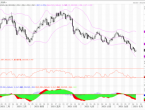The bond market warned that the Fed might lose control of CPI pressure! Fear of raising interest rates in advance?
Recently, a closely watched indicator of long-term inflation expectations in the U.S. bond market indicates that the Fed may lose control of rising inflationary pressures. Analysts of major investment banks analyzed the way the Fed is about to start the cut and the impact of the US debt ceiling issue on the bond market. It is worth noting that continued supply chain chaos may maintain inflation at a high level, raise inflation expectations, and force the Fed to raise interest rates early in 2022.
U.S. debt strategists study the Fed's possible reduction in size and the impact of the debt ceiling agreement
US interest rate strategists at Bank of America and Deutsche Bank stated in their weekly research reports that the short-term debt ceiling agreement will allow US Treasury yields to rise further, but Barclays and Goldman Sachs believe that economic downside risks should limit the bond market's decline. Strategists also considered possible reductions in the Fed's approach.
Bank of America (Mark Cabana, report on October 8)
The short-term trend of U.S. debt will continue due to improved US economic data, fiscal progress, Fed’s hawkish tone and technical factors. However, if the 10-year Treasury bond yield reaches 1.75% before the end of the year, it is recommended not to continue shorting, because if there is no wage Inflation, the Fed may continue to support economic growth and keep policy accommodative. Even if Powell is re-elected as chairman, the composition of the Fed's decision-making team will look even more dovish next year. As the economic recovery matures, economic growth and inflation should cool down next year.
Barclays (Anshul Pradhan, report on October 8)
The sharp rise in U.S. Treasury yields in the past month has shown a sell-off of Treasury bonds dominated by maturity premiums. It reflects more aggressive downsizing than expected, downside risks brought about by virus variants, and the impact of rising energy prices on inflation, all of which have pushed up the actual term premium and inflation risk premium. Downside risks to the economy should limit selling in the bond market.
Bank of Montreal (Ian Lyngen, Ben Jeffery, report on October 8)
Regarding the Fed’s reduction, the monthly reduction in the purchase of US$10 billion in Treasury bonds and US$5 billion in mortgage-backed securities will appear simple and will be in line with the guidelines for ending the reduction in mid-2022. This week’s Treasury auction should benefit from the debt ceiling debate postponed to December 3.
Deutsche Bank (Steven Zeng, report on October 8)
The debt ceiling agreement should improve risk sentiment and help push up interest rates. The Fed may announce a reduction in the FOMC meeting in November; the committee may only provide a wide range of parameters and leave the details to the open market operations department. In this case, the first purchase by the New York Fed after the November 3 meeting will show a reduced purchase amount.
Goldman Sachs (Praveen Korapaty, report on October 8)
It is expected that the rate of return volatility should decline, as economic growth is decelerating and expectations of underweights have been digested by the market. The sell-off of U.S. Treasuries should start to lose momentum, but the September CPI may push up interest rates.
TD Securities (Priya Misra, others, report on October 8)
The possibility of underweight in November still exists, but the weak employment report in September should suppress some enthusiasm for interest rate hike pricing in 2022, and salary data will put upward pressure on long-term yields, because concerns about stagflation persist . It is recommended that investors hold 5-year US Treasury bonds, and the 10-year real interest rate is expected to continue to rise. At the same time, the 5s30s yield curve is expected to become steeper, as the Fed’s interest rate hike is expected to shift from December 2022 to the end of 2023.
U.S. inflation expectations are approaching a 7-year high, and the Fed may have to raise interest rates ahead of schedule
The 5-year forward breakeven inflation rate is close to the highest level in about seven years. This is the second time the index has issued a similar warning in recent months. In May, a similar rise prompted Brian Sack, the former head of monetary and financial market analysis for the Federal Reserve Board of Governors, to join other officials, warning the Fed of the need to signal a policy adjustment.
Although the Fed said in June that it would start discussing the reduction of bond purchases, which paved the way for the November reduction statement issued last month, the spiraling energy prices and rising wages have once again pushed up the breakeven inflation rate. With the upcoming price cuts are considered to be no more suspense, only hints about the timing of interest rate hikes can be considered by the market as a signal of the Fed's partial eagle.
Deutsche Bank said: " Inflation expectations are now clearly out of the low-inflation mechanism. The 5-year forward break-even inflation rate once again hit the 250 basis point mark. There is sufficient evidence that the break-even indicators will eventually'cross the Rubicon.' , Break away from the low-inflation mechanism after 2014."
Earlier this month, the median expectation of the University of Michigan Consumer Confidence Survey showed that in September, consumers’ expectations for the inflation rate in the next five to ten years rose to 3%, tying the nearly 8-year high reached in May.
As of October 1, the Fed’s own 5-year forward break-even inflation rate was 2.28%. It reached 2.55% on May 11, the highest level since February 2014. As of October 8, a similar indicator developed by Bloomberg has been updated more frequently from 2.24% on October 1 to 2.36%.
Continued supply chain chaos may maintain inflation at a high level, raise inflation expectations, and force the Fed to raise interest rates early in 2022.











